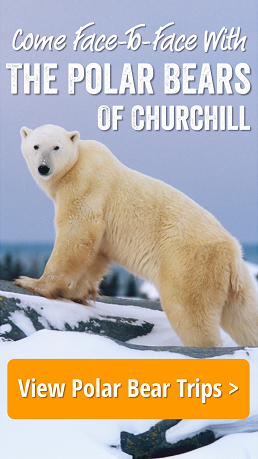by Steve Selden | Apr 25, 2016 | Churchill Photography
This incredible photo by Roie Galitz captures a rare scene ever to be observed by humans. Persistent Polar bears spend endless hours stalking and hunting seals out on the Hudson Bay pack ice.This is one of those very special moments for a wildlife photographer and could very well be the photo of the year. Enjoy!
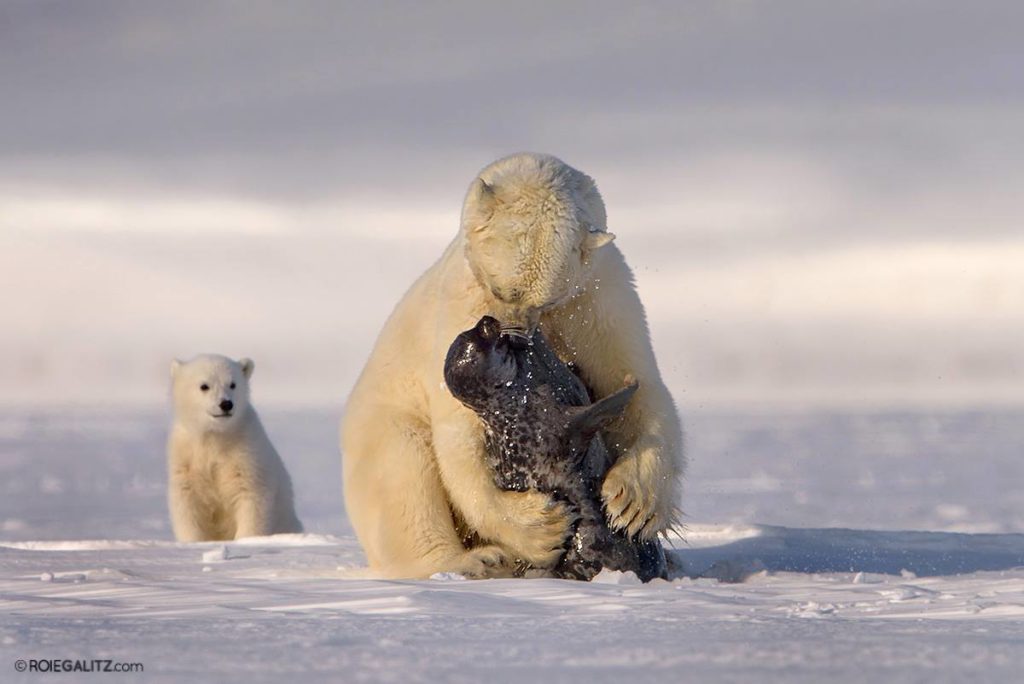
A mother polar bear captures a seal for sustenance and gives her a cub a valuable teaching moment Roie Galitz photo.
by Steve Selden | Apr 23, 2016 | Churchill Photography
As the Churchill Arctic summer nears we will be anxiously awaiting the arrival of thousands of beluga whales, some with their calves, from the north. I can’t wait to see images from the season and all the other Arctic treasures around the tundra. Stay tuned for the fantastic experiences reported here throughout the summer.
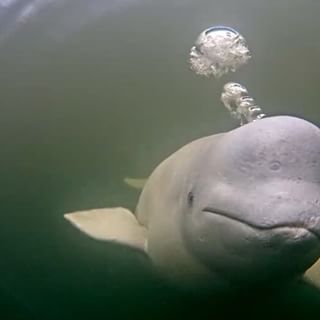
Beluga whales will soon be all around the Churchill River estuary as summer nears! Alex De Vries Magnifico photo.
by Steve Selden | Apr 22, 2016 | Videos
Some video footage shot by Natural Habitat Adventures guide Rinie van Meurs. Polar bears can dive for extended time under water though this video shows what appears to be a record dive by this particular animal. Enjoy this raw footage!
by Steve Selden | Apr 20, 2016 | Videos
This fascinating view from space of the shimmering northern lights is unique though still nothing like seeing them in the open, cool air of the north country and Churchill, Manitoba! January through March is the peak time to see the spectacular northern lights right above you in Churchill. Head north next year and enjoy a once in a lifetime experience from the tundra!
by Steve Selden | Apr 19, 2016 | Conservation
Canadian Arctic polar bears are swimming longer distances to find suitable ice in which to hunt seals and rear their young. Scientists are deeply concerned that such swims of several days duration, particularly in the Beaufort Sea, are the cause of population decline in the Arctic.
Canadian researchers tracked 58 adult female polar bears as well as 18 young male and female bears between 2007 and 2012 in the Beaufort Sea. Another group of 59 adult females in the Hudson Bay region were tracked as well. Since adult males typically remove their collars and their larger neck size generally makes it difficult to attach the collars, only the females were tracked.

Polar bears are swimming longer distances especially in the Beaufort Sea. Andrew Derocher photo.
Overall, the Hudson Bay polar bears, those including the Churchill population, rarely made long-distance swims.
However, in the Beaufort Sea, during times when sea ice dissipates, many of the polar bears made at least one swim of 50 km or more while 69 per cent did so in 2012, a record low year for ice coverage.
“More and more animals in the population are being caught in places that they just can’t stay – so the ice that they’re on is breaking up, the floes are too small, and they have to make longer distance movements to try to find better habitat,” said Andrew Derocher, a University of Alberta biologist highly involved in the study.
Researchers identified a total of 115 long-distance swims during the study, 100 of them in the Beaufort Sea, with the average distance being 92 km or thew equivalent of 3.4 days. Polar bears average swimming speed is around two km/hour. The bears have very little rest while swimming, rarely stopping and since swimming burns calories at a higher rate than walking, body fat needed for Arctic survival burns away rapidly. One female was tracked on a nine – day, 687 km swim lost her cub on the journey while also dropping 22 per cent of her weight.
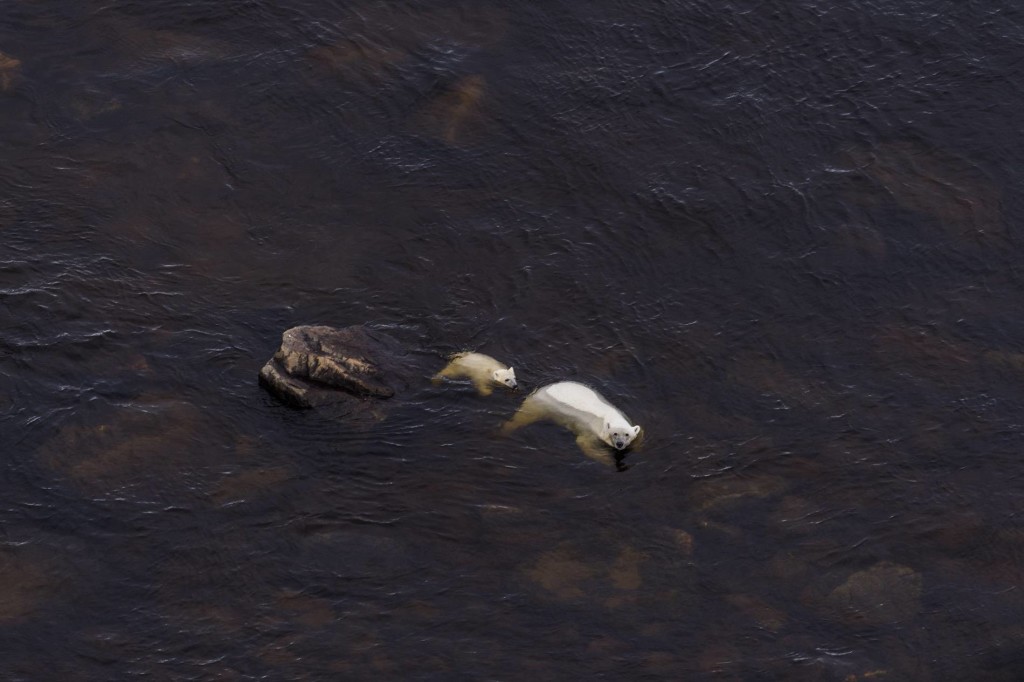
Polar bear sow and cub swimming in the Hudson Bay. John Lehmann photo.
The polar bear population in the Beaufort Sea has fallen more than 50 per cent in the past 10 years, according to Derocher. The long – distance swimming could have a huge bearing on this data. “So it is a concern that this is probably one of the factors associated with the population decline,” he said.
However, the study found no direct evidence that swimming contributes to the population decline. The polar bears tracked survived all the swims recorded in the study. Researchers were unable to track survival rates of cubs whom may have been with them other than the one extended swim referred to above. Due to hypothermia exposure to cubs, mothers with young seemed to make fewer marathon swims the researchers noted.
“Polar bears are well adapted to swimming,” Derocher said, “but of course, not all polar bears are created equal when it comes to the ability to swim.” Younger bears do not have the insulating body fat nor the stamina for prolonged water journeys.
Until the 1980’s Sea ice in the Beaufort Sea always melted close to shore as summer arrived. With the ice edge visible from land, polar bears utilize that edge during migration as a way to manage their hunting grounds. As the Arctic warms and the summer sea ice edge extends farther and farther north, polar bears are forced to swim long expanses to find stable ice.

Polar bears will need to find alternate food sources in order to survive. Andrew Derocher photo.
The dynamic Hudson Bay polar bear population has adapted to ice completely melting in summertime by spending long periods of time on land and in the shallows. Reliant on other food sources, polar bears in this region, including Churchill, have adapted somewhat and continue to develop ways to augment their winter food sources. Beluga whales, berries, bird – eggs and land seal – kills are more common food sources these days for the animals.
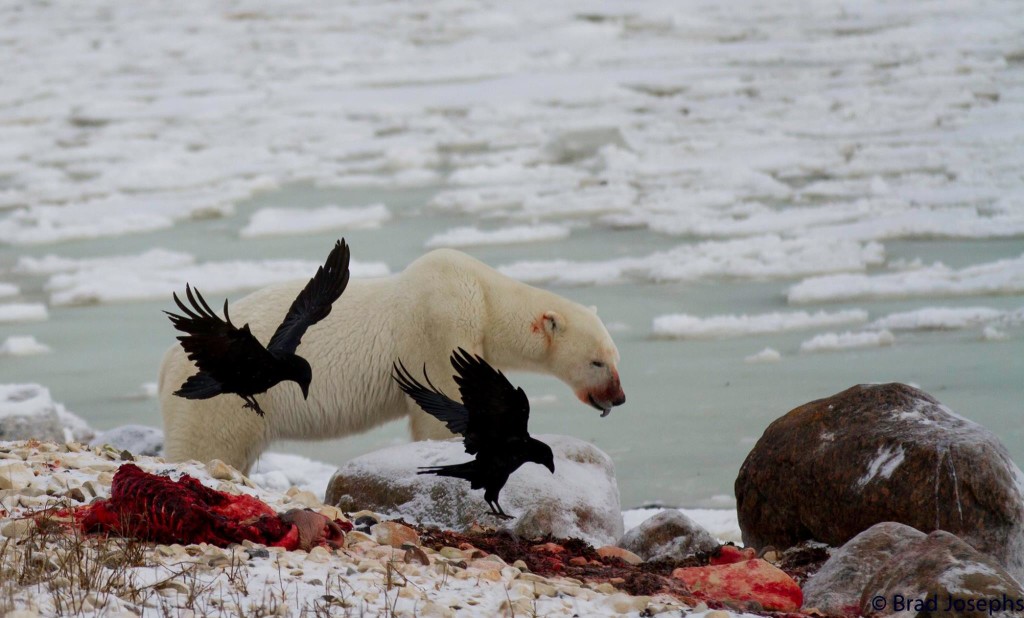
Polar bear and ravens scavenge a seal kill carcass on land in Churchill Wildlife Management Area. Brad Josephs photo.
Despite Scientists previous predictions that polar bears would need to swim farther as climate change causes chaos with Arctic sea ice, this was the first study showing enough data to actually show the correlation.







